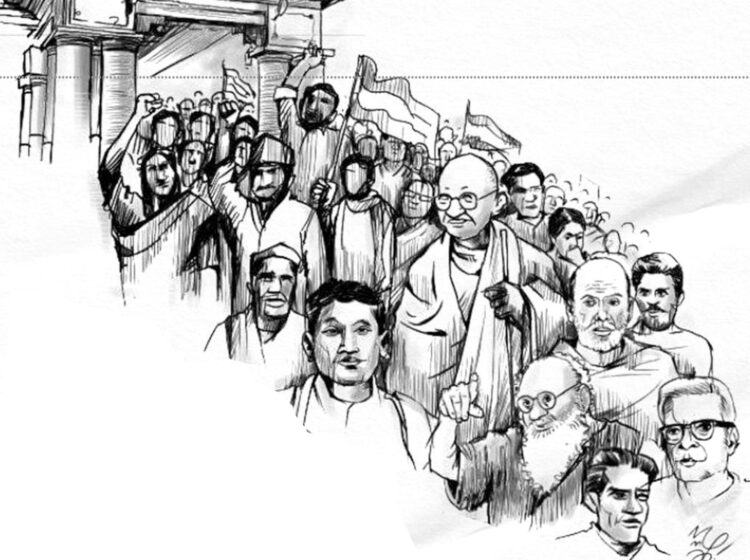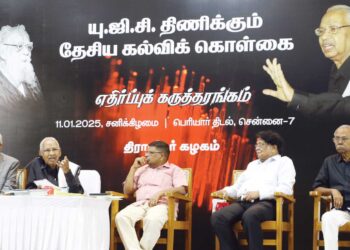The following excerpts are from, “Vaikkam Satyagraha and Gandhi” research work done by Prof.Dr.T.K. Ravindran, Historian, published by Sri Narayana Institute of Social and Cultural Development, Trichur, 1975
But the support the Vaikkom Satyagrahis received from Madras, both in money and leadership, was very great and impressive.E.V.Ramasami Naicker’s lead gave a new life to the movement. His stirring appeal on the eve of his journey to Kerala had made a deep impression on the mind of Tamil Nadu. He said “the command from the neighbouring sister province of Kerala is irresistible. A grave situation has arisen. Repression is rampant. Satyagrahis and leaders, including Sriman Joseph in trying to remove untouchability the corner stone of our Mahatma’s programme—have been made the victims of it. These considerations far out-weigh in my mind and I have started. Perhaps I may also be arrested; but it is nothing. I appeal to all sympathisers, be they leaders, propagandists, volunteers or persons of whatever creed, to flock to Kerala.
Those that cannot do so, can at least give their financial aid. Many volunteers in Tamil Nadu have often said and also written to me that they were only looking forward to a Satyagraha and still many others that they would suffer in the cause of the removal of untouchability. Hark Ye, all those such, here is a golden opportunity. Fail not to avail of it. Hasten up every one of you and join the noble cause.” His inspiring speeches in the villages around Vaikkam and other places in Travancore moved the people to the depth. His cold logic and incising arguments succeeded in attracting larger numbers of vacillating minds to the side of Satyagraha and converting many opponents too. After a few days of his leading the campaign he withdrew to the villages for propagating the ideal of Satyagraha and joined the Congress deputation that visited different places.
A Satyagraha Deputation consisting of prominent Congressmen was instituted on the advice of Gandhi in order to propagate the ideal and message of Satyagraha among the people of Travancore and to make them conscious of their duty to lend support for the epic struggle at Vaikkam. The Deputation did splendid work in the cities and villages in collecting money and volunteers for the successful working of the campaign.Ramasami Naicker, Dr.Emperumal Naidu, Mannath Padmanabhan, Mathunni, Chittedathu Sanku Pillai, Rama Krishna Das, Ayyamuthu Gounder and Govindan Channar were the members of the Deputation. Their activities in the interior parts of Travancore brought a welcome change in the attitude of the conservative people. Ramasami Naicker’s speeches were especially impressive and their savage force cut through the prestige of the Travancore Government. He was arrested and sent to jail several times.Prohibitory orders were served on other members of the Satyagraha Deputation and most of them were detained for breaking these orders.
Locally, wind of public opinion started blowing in favour of the satyagraha.Ilava community which remained neutral, if not positively apathetic since the inception of the campaign, came round with warm support in terms of money, materials and volunteers. This change of attitude was the direct result of the inhuman atrocities committed by the Savarna blusteters on the non-violent satyagrahis of which mention will be made later.
On taking stock of the situation by the Satyagraha Publicity Office it was found that caste observances and vicious caste thinking at Vaikkam and surrounding areas had become considerably more rigorous and stiff than before.
The violent and disloyal utterances of some speakers in public meetings rudely shocked the minds of the loyal citizens of Travancore. Lower castes on whose behalf all these were said and done, as a rule, were too much attached to their sovereign that a great many of them thought it a sin, apart from being a political blunder and an attempt at social suicide on their part, to associate themselves with the activities of the agitators who preached sedition. T.K. Madhavan, the guiding spirit of the new reform movement, had to come out with a statement disapproving this attitude of some Satyagraha workers.
A few examples of such speeches can be cited to show how the ordinary people must have been scared away from the movement. Mr.K.G. Kunjukrishna Pillai said, “who can say that our actions are wrong. Only one can be of opposite view. The one true hindrance to our right is His Highness the Maharaja. Even if His Highness or a few Brahmins or a few Nairs act against us, we will not be defeated. Even if His Highness hinders us, we will do whatever we have to do.
E.V.Ramasami Naicker of Madras in a public meeting at Vaikkam said, “The Travancore Government have brought out the plea that the Vaikkam temple road belongs to the Devaswam. As the whole of Travancore is dedicated to Padmanabhaswami, neither the Travancore Maharaja nor his predecessor nor his grand-father has any right over it. By virtue of this, everything in Travancore has become the property of the Devaswam.” “It can be said that it is the Maharaja who is responsible for the Congress volunteers starving and putting them behind the bars and humiliating. If another takes away the Raja’s consort or the Raja takes another’s wife, the Raja does not feel ashamed”. Dr.Emperumal Naidu warned the king “wherever slavery is established there is downfall; You Rajah, what you are striking against is a rock. The rock is not going to get hurt, but your head will split. We know that Belgians fell because they molested the Africans. Ah, Maharaja, you are also a slave.”
These and similar speeches made by the Satyagrahis and their supporters did neither breathe the spirit of tolerance, nor the sentiment of love. The propaganda work, intended to spread the ideal of Satyagraha, turned out to be one for spreading sedition, according to conservative opinion of the day. “There is a world of difference between satyagraha meant to be an educative force, and satyagraha intended as an instrument of coercion of the Government and through them of the orthodox Hindu”, said Dewan T. Raghaviah. Gandhi endorsed this view and said that the Satyagrahi’s appeal had been to the reason of the orthodox. “I make bold to state”, he wrote in Young India, “that from the very outset Satyagraha at Vaikkam was intended to be an educative force and never an instrument of coercion of the orthodox. It was for that reason that the fast against the orthodox was abandoned. It was to avoid coercion of the Government by embarrassment that barricades have been scrupulously respected. It was for that reason that no attempt was made to dodge the Police.”
He continued, “Experience has shown that mere appeal to reason produces no effect upon those who have settled convictions. The eyes of their understanding are opened not by argument but by the suffering of the Satyagrahi. The Satyagrahi strives to reach the reason through the heart. The method of reaching the heart is to awaken public opinion. Public opinion for which one cares is a mightier force than that of gun powder.” But it is obvious that the tactics of individual agitators at times, especially after the arrest of all prominent leaders of the movement, certainly served to undermine the ideal set by Gandhi and created an impression in minds of the orthodox and the Government that Satyagraha was an instrument of coercion. This is evident from the report against the Satyagrahis that “as though to demonstrate their practical faith in Hindu-Muslim unity, some of them were impertinent enough to proceed very near the temple and short in chorus “Allah-ho-Akbar” before the God.”
In their attempt to glorify suffering the Satyagrahis, it appears, institutionalised suffering itself through artful propaganda and advertisement. In order to reach the heart of the opponents very often they tried to pierce it with taunts or undignified words. In theory Vaikkam Satyagraha was the argument of suffering. As Gandhi said, “the Satyagrahis dare not be irritated against their opponents. The hardest heart and the grossest ignorance must disappear before the rising sun of suffering without anger and without malice.” But in order to institutionalise suffering of the satyagrahis a lot of intellectual excretion had to be thrown at their opponents by way of mendacious and cheap propaganda. To that extent the suffering lost its ethical charm and glory.







